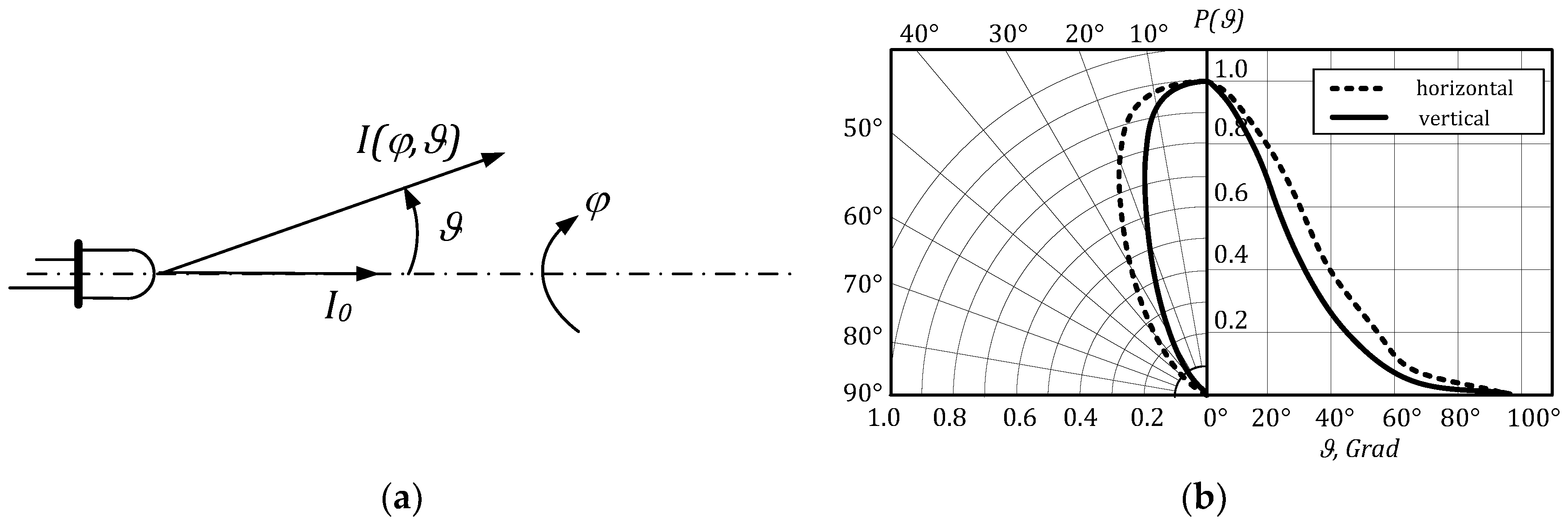Improvement of the Approximation Accuracy of LED Radiation Patterns
Abstract
:1. Introduction
2. Analysis of Radiation Patterns
- It must be even since the pattern is symmetric to the optical axis;
- It must be normalized, i.e., for any admissible value of the parameters (then the approximation Functions (4) and (7) become equal).
3. About the Algorithm for Calculation of the Parameters
4. Validation of the Proposed Algorithm
4.1. Parameter Evaluation
4.2. Resistance of the Algorithm
4.3. Root Mean Square Error
5. Conclusions
- The decrease of the error depends on the measured LED radiation pattern. The error decreases less when the true pattern is well described by the Function (4). Then the algorithm calculates so large that the Gaussian function is practically irrelevant. In addition, for narrower patterns, the increase in accuracy is less, as the overall error, in this case, is determined by the error in the measurement of the diagram (the weight of each point is large);
- The proposed algorithm works correctly and allows the determination of the estimated parameters and effectively.
Author Contributions
Funding
Conflicts of Interest
References
- Schubert, E.F.; Kim, J.K. Solid-state light sources getting smart. Science 2005, 308, 1274–1278. [Google Scholar] [CrossRef] [PubMed]
- Kaminski, M.S.; Garcia, K.J.; Stevenson, M.A.; Frate, M.; Koshel, R.J. Advanced Topics in Source Modeling. In Proceedings of the International Symposium on Optical Science and Technology, Seattle, WA, USA, 16 August 2002. [Google Scholar]
- Parr, A.C.; Datla, R.; Gardner, J. Optical Radiometry; Elsevier Science: Philidelphia, PA, USA, 2005. [Google Scholar]
- Moreno, I.; Sun, C.-C. Modeling the radiation pattern of LEDs. Opt. Express 2008, 16, 1108–1189. [Google Scholar] [CrossRef]
- Shin, J.-Y.; Kim, T.W.; Kim, G.-Y.; Lee, S.-M.; Shrestha, B.; Hong, J.-W. Performance enhancement of organic light-emitting diodes using electron-injection materials of metal carbonates. J. Electr. Eng. 2016, 67, 222–226. [Google Scholar] [CrossRef]
- Schuber, E.F. Light-Emitting Diodes, 2nd ed.; Cambridge University Press: Cambridge, UK, 2006. [Google Scholar]
- Di, Y.J. Rapid LED Optical Model Design by Midfield Simulation Verified by Normalized Cross Correlation Algorithm. In Proceedings of the EECM 2011 International Conference on Electronic Engineering, Communication and Management, Beijing, China, 24–25 December 2011; pp. 151–156. [Google Scholar]
- Wang, Y.; Chen, M.; Wang, J.Y.; Shi, J.; Yang, Z.; Pan, Y.; Guan, R. Impact of LED transmitters’ radiation pattern on received power distribution in a generalized indoor VLC system. Opt. Express 2017, 25, 22805–22819. [Google Scholar] [CrossRef] [PubMed]
- Marinov, M.; Dimitrov, S.; Djamiykov, T.; Dontscheva, M. An Adaptive Approach for Linearization of Temperature Sensor Characteristics. In Proceedings of the 27th International Spring Seminar on Electronics Technology; Bankya, Bulgaria: 13–16 May 2004; pp. 417–420.
- Rachev, I.; Petrova, G. Application of the Least Squares Method for Signal Processing and Determination of Parameters in Mechanical Myotonometry. IPASJ Int. J. Electron. Commun. 2016, 4, 001–008. [Google Scholar]
- Forsythe, E.; Malcolm, M.A.; Moler, C.B. Computer Methods for Mathematical Computations; Prentice-Hall: Upper Saddle Revier, NJ, USA, 1977. [Google Scholar]
- Peitgen, H.-O. Newton’s Method and Dynamical Systems; Springer: Berlin, Germany, 2011. [Google Scholar]
- Johnson, M. Photodetection and Measurement: Maximizing Performance in Optical Systems; McGraw-Hill: New York, NY, USA, 2003. [Google Scholar]
- Jiang, N.; Zou, J.; Zheng, C.; Shi, M.; Li, W.; Liu, Y.; Guo, B.; Liu, J.; Liu, H.; Yin, X. Fabrication Process and Performance Analysis of CSP LED Filaments with a Stacked Package Design. Appl. Sci. 2018, 8, 1940. [Google Scholar] [CrossRef]
- Quan, L.P. A Computational Method with MAPLE for a Piecewise Polynomial Approximation to the Trigonometric Functions. Math. Comput. Appl. 2018, 23, 63. [Google Scholar] [CrossRef]






| LEDs | RMSE | |
|---|---|---|
| LED C3535SIRC-2B | 0.0329 | 0.0118 |
| L-53SF7C | 0.0354 | 0.0332 |
© 2019 by the authors. Licensee MDPI, Basel, Switzerland. This article is an open access article distributed under the terms and conditions of the Creative Commons Attribution (CC BY) license (http://creativecommons.org/licenses/by/4.0/).
Share and Cite
Rachev, I.; Djamiykov, T.; Marinov, M.; Hinov, N. Improvement of the Approximation Accuracy of LED Radiation Patterns. Electronics 2019, 8, 337. https://doi.org/10.3390/electronics8030337
Rachev I, Djamiykov T, Marinov M, Hinov N. Improvement of the Approximation Accuracy of LED Radiation Patterns. Electronics. 2019; 8(3):337. https://doi.org/10.3390/electronics8030337
Chicago/Turabian StyleRachev, Ivan, Todor Djamiykov, Marin Marinov, and Nikolay Hinov. 2019. "Improvement of the Approximation Accuracy of LED Radiation Patterns" Electronics 8, no. 3: 337. https://doi.org/10.3390/electronics8030337
APA StyleRachev, I., Djamiykov, T., Marinov, M., & Hinov, N. (2019). Improvement of the Approximation Accuracy of LED Radiation Patterns. Electronics, 8(3), 337. https://doi.org/10.3390/electronics8030337






